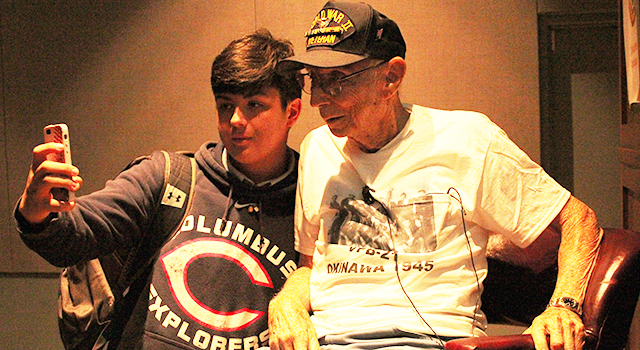By Cristina Cabrera Jarro -
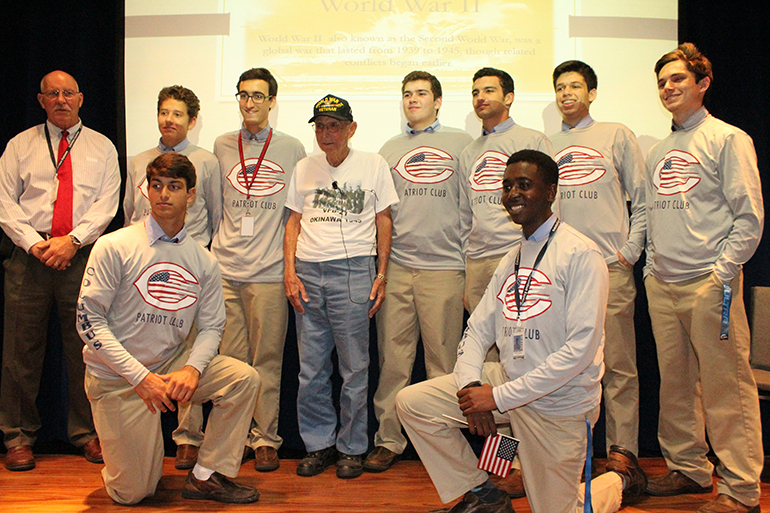
Photographer: CRISTINA CABRERA JARRO| FC
Members of Christopher Columbus High School's Patriot Club pose with World War II Todd Silverman (center) after his presentation. The club is moderated by guidance counselor Carter Burrus (far left), who served in the U.S. armed forces.
MIAMI | He was 16 when Pearl Harbor was bombed on Dec. 7, 1941, and though underage to enlist, Todd Silverman wanted to answer the call to arms.
“Our greatest fear that day was that we would beat them in six months and I would miss the whole war,” said Silverman. “I later found out that I had vastly underestimated the enemy.”
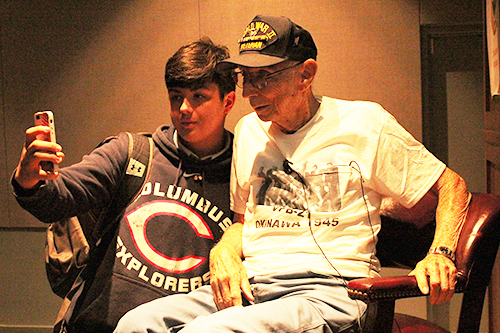
Photographer: CRISTINA CABRERA JARRO| FC
A Columbus High School student takes a selfie with World War II vet Todd Silverman, thanking him for his service.
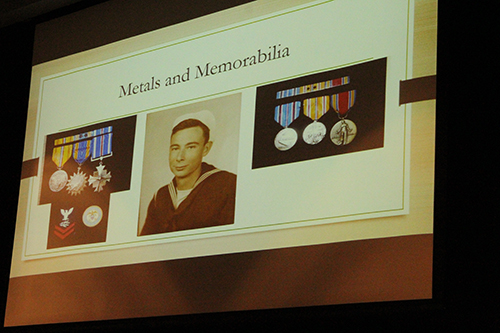
Photographer: CRISTINA CABRERA JARRO| FC
A photo of U.S. Navy Aviation Radioman Todd Silverman at the age of 18. The medals surrounding his photo include victory medals, air medals, a distinguished flying cross, a medal for fighting in the American theater and medals for fighting in the Asiatic-Pacific theater.
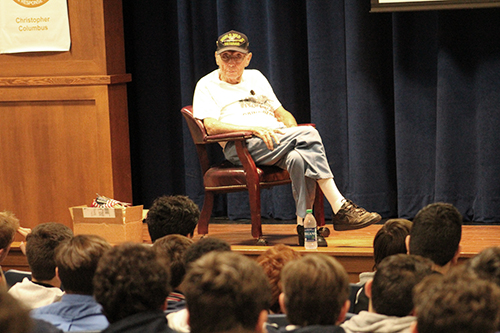
Photographer: CRISTINA CABRERA JARRO| FC
World War II vet Todd Silverman speaks to Columbus High School students. Silverman was a U.S. Navy Aviation Radioman who served in the Battle of Okinawa.

Photographer: CRISTINA CABRERA JARRO| FC
A photo of U.S. Navy Aviation Radioman Todd Silverman at the age of 18. The medals surrounding his photo include victory medals, air medals, a distinguished flying cross, a medal for fighting in the American theater and medals for fighting in the Asiatic-Pacific theater.
Silverman, now 90, shared his journey as a World War II U.S. Navy Aviation Radioman with students of Christopher Columbus High School recently at a Celebrate Freedom Day. His talk gave the students a chance to listen to someone who has lived the history they learn from textbooks.
“He gave a different perspective of how the war was,” said David Caserta, a junior at Columbus. “I’ve only read books about it and stuff, so I guess meeting someone that was actually in it and sharing their feelings was pretty enlightening.”
A native of Wauchula, Florida, Silverman enlisted at 17, after obtaining his high school diploma in June 1943. After a very brief — three weeks — boot camp in Jacksonville, he attended Aviation Radio School in the Naval Air Station in Jacksonville, where he says he was truly pushed. Through 16 weeks of “grueling studies” he learned Morse international code, and peaked at transmitting 15 words a minute; the expectation was 24. Fear of failure, however, inspired persistence.
“You didn’t want to flunk out of radio school in Jacksonville,” said Silverman. “Those that flunked out went to Charleston, South Carolina, and became members of the armed guard.”
After radio school, Silverman went to radar school when “radar was in its infancy.” Gunnery school proved to be one of his favorites, perhaps because he was an experienced hunter.
“We hunted back then because a lot of the things you couldn’t buy back then,” said Silverman. “You had to go out and shoot birds. You can buy quail now, you can buy duck, you can buy rabbit. Coming up in the Depression was not real easy. They were tough times. My father had to do a lot of work to raise four children.”
Transferred to San Diego and later Corpus Christi, Texas, he was assigned to work aboard PBY Catalina seaplanes, used for patrol bombing, convoy escorts, search and rescue and other missions.
“It was slow,” Silverman said. “It cruised at about 80, 85 knots. If a duck was coming up behind us we just waved it around.”
As the war continued, so did the race for better, faster, and more powerful weapons. When the PBM Mariner patrol bomber planes were introduced, Silverman volunteered for transfer to Banana River, Florida — 150 miles from his home.
There he met 11 crewmen who would accompany him on 21 missions. The crew from 12 different states consisted of pilots, radiomen, mechanics and co-ordinance men. Their large plane was capable of flying for over 17 hours when it was not stationed aboard the USS Chandeleur in the Pacific.
One night, they spotted 30 ships from the Japanese fleet. Silverman recalled flying over the convoy for over three hours without either side firing a single shot. Some might call that a blessing or luck; others would call it insanity. But as any serviceman would say, “In the military you do what you’re told to do.”
In times of tribulation, Silverman remained hopeful. It was that positive outlook that carried him and many others through the war.
“I’m an optimist, I’ve always been an optimist,” he said. “I was during the war when we flew over the Golden Gate going to the Pacific. We optimists said, ‘Back alive in ’45.’ Pessimists said, ‘Golden Gate in ’48.’ We were right. We dropped the hook in Seattle on December 2, 1945. We were back. We had done our little bit of the war effort. I feel good that I was able to contribute just a little bit in the greatest Navy in the war.”
Silverman returned home with a renewed appreciation for life. He recalled how before the war, people didn’t travel as much so he took it upon himself to see the world. His adventures ranged from riding camels in the desert in Australia to seeing New Zealand and hiking and rafting the Grand Canyon. He also took advantage of the GI Bill and continued his education.
But like anyone with flying experience, he couldn’t resist the opportunity to fly again. He took to the skies on a PBY Catalina, a B17, a B24, and most recently a B51 Mustang — his favorite flight.
“We did rollovers,” Silverman said.He also relishes sharing his story with younger generations through the Joe Foss Institute, a nonprofit organization that works “to close the civics education gap and prepare young Americans for civic engagement as voters and informed members of their community.”
“With all our problems, we’re in the best country in the world,” said Silverman. “To remain the best country it depends on people like you guys. And I know that you will carry on and our country will continue to be super great… The future of our country is with you guys. It ain’t with me. I have a lot more days behind me than I have ahead of me. But I’m an optimist. I think I got a few more good days.”
